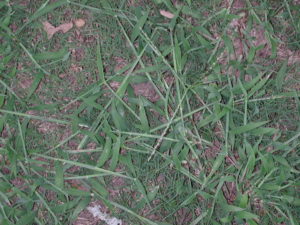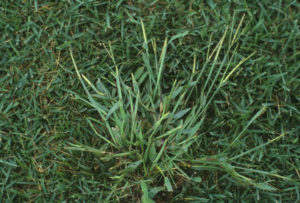Crabgrass is a warm-season annual grass that is commonly found in pastures and hay meadows in parts of Texas. Relative to other warm-season annual grasses, crabgrass has a low- to medium-yield potential but is high in forage quality. As such, it is often a desirable component in pastures and is sometimes planted for forage in pastures. As is the case with many annual grass species, crabgrass is a prolific seed producer which enables new stands to establish in subsequent growing seasons for summer grazing.
Due to its high-volume seed production, crabgrass also has the potential to become a problematic and persistent weed in hay meadows. Its competitive growth among perennial grass hay meadows contributes to stand thinning from spring to late summer; thus, growers are concerned about its economic impact. Crabgrass has a slower drying rate than most hay species, which causes rotting and mold development after baling. Once it is dry, crabgrass often turns a dark brown or black color, which stands in stark contrast to the bright green color of other grass hay crops. This can substantially lower the value of the hay crop, so controlling the growth of crabgrass may be critical for long-term successful production.
So how to manage unwanted crabgrass?
If the hay meadow happens to be fenced as well as have a source of water, grazing can be an excellent way to utilize the high-quality crabgrass forage as well as remove it from the meadow. Grazing pressure can reduce seed production and reduce further spread of crabgrass.
Use of herbicides to control crabgrass is probably the most common method practiced. Prowl H2O (pendimethalin) is a preemergence herbicide labeled for dormant bermudagrass and bahiagrass pastures and hay meadows. Treatments should be applied in late winter/early spring before crabgrass emerges. This herbicide should also be applied prior to rainfall for the herbicide to receive adequate incorporation into the soil. Rezilon (indaziflam) is a preemergence herbicide also labeled for bermudagrass and bahiagrass pastures and hay meadows. Rezilon should be applied well before weed emergence. Once applied, it can sit on the soil surface for some time with no degradation from sunlight while waiting for rainfall activation.
Glyphosate (active ingredient in Roundup, etc.) and Pastora (nicosulfuron + metsulfuron) are two postemergence herbicide options labeled. Spot treatments of glyphosate are recommended in bahiagrass for control. As with any herbicide application timing is critical along with following label directions. When spot treating with glyphosate, crabgrass needs to be sprayed when plants are less than 6 inches in height in the spring. Unfortunately for bahiagrass growers there are no selective herbicides available for postemergence control of crabgrass. For rates and any restrictions refer to product labels.
Pastora may only be used in bermudagrass, for suppression of large crabgrass (large crabgrass here refers to a species of crabgrass, not the size of crabgrass) only. “Suppression” only means a reduction in weed competition, and does not necessarily guarantee that the weed will be fully controlled. If using Pastora for this purpose, applications should be made to newly emerging crabgrass seedlings less than 2 inches in height.
Vanessa Corriher-Olson
Professor, Forage Extension Specialist
Soil & Crop Sciences
Texas A&M AgriLife Extension, Overton,TX
903-834-6191

